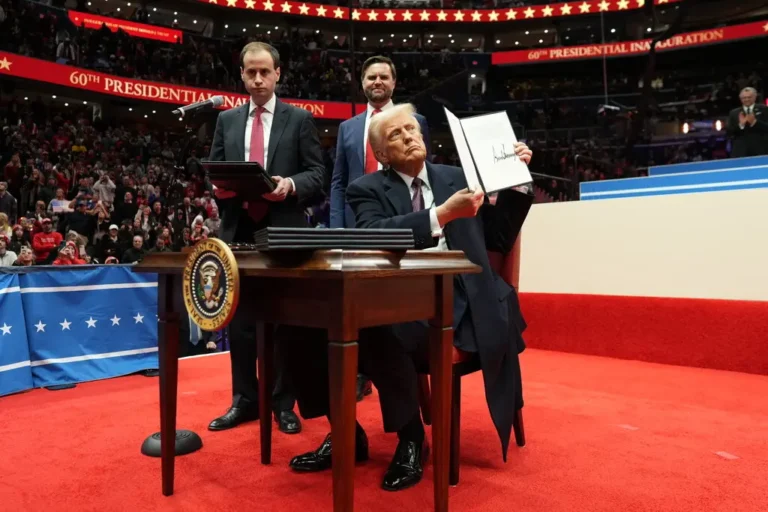Trump executive orders
Just two hours after his inauguration, President Donald Trump took swift action, seated in the President’s Room at the U.S. Capitol, to sign the first of what he promised would be nearly 100 executive orders. This historic undertaking, aimed at delivering on his campaign pledges, marked the start of what he described as “the complete restoration of America and the revolution of common sense.”
Trump’s first executive order, signed within hours of assuming office, set the tone for an ambitious agenda focused on rapidly implementing policy changes across a wide array of issues. He underscored that these orders were part of his commitment to the American people, whom he promised to serve by cutting through what he saw as governmental inefficiency and overreach. The act of signing so many orders in quick succession was not just symbolic but a practical demonstration of his determination to reshape the federal government’s role.
Flanked by key members of his administration and Congressional leaders, Trump sat at the ornate desk in the President’s Room, a setting rich with historical significance. The room, located just off the Senate floor, has witnessed countless moments of American history, and Trump’s presence there added a new chapter to its legacy. As cameras flashed and reporters took notes, Trump signed the first document with a flourish, pausing occasionally to hold up the signed orders for the cameras, a gesture that would soon become a hallmark of his presidency.
The first batch of executive orders covered a wide range of topics, from immigration and healthcare to regulations and trade policies. One of the most notable orders in the initial set was aimed at beginning the dismantling of the Affordable Care Act, a move that Trump had long touted on the campaign trail. This particular order directed federal agencies to minimize the financial burden of the healthcare law as Congress worked on a repeal and replacement plan.
Another significant order was related to immigration, signaling the beginning of what would become a cornerstone of Trump’s presidency: a hardline stance on immigration policy. This order laid the groundwork for increased border security measures and the construction of a wall along the U.S.-Mexico border, a signature promise that had become a rallying cry among his supporters.
In addition to these high-profile issues, Trump also signed orders targeting federal regulations, aiming to reduce what he and his supporters viewed as burdensome red tape hindering American businesses. By instructing agencies to identify and roll back regulations deemed unnecessary or harmful to economic growth, Trump aimed to stimulate business development and create jobs.
The sheer number of executive orders Trump planned to issue was unprecedented, reflecting both his impatience with the legislative process and his desire to make immediate changes. Critics, however, raised concerns about the use of executive orders to bypass Congress, warning that such actions could undermine the democratic process and lead to overreach by the executive branch.
Nevertheless, Trump’s supporters hailed his decisiveness, arguing that the country needed a strong leader who could make bold moves to disrupt the status quo. For them, Trump’s approach was a refreshing change from the perceived stagnation of Washington politics, and his willingness to use executive power was seen as a necessary tool to fulfill his promises.
As the day wore on, Trump continued signing order after order, each one bringing a new wave of reactions from both supporters and opponents. The President’s Room, typically a quiet space for reflection and ceremonial duties, was transformed into a hub of executive action, with Trump’s pen scribbling across the pages of history.
By the end of his first day, Trump had signed more executive orders than many of his predecessors had in their entire first weeks in office. It was clear that this was just the beginning of an administration that would be defined by its aggressive use of executive power, a strategy that would continue to draw both applause and criticism as Trump sought to fulfill his vision of a restored America.






